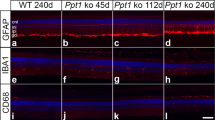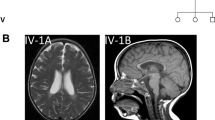Abstract
The neuronal ceroid lipofuscinoses (NCLs) represent a group of common recessive inherited neurodegenerative disorders of childhood, with an incidence of 1:12,500 live births1. They are characterized by accumulation of autofluorescent lipopigments in various tissues. Several forms of NCLs have been identified, based on age at onset, progression of disease, neurophysiological and histopathological findings and separate genetic loci2,3,4,5,6,7,8,9. All types of NCL cause progressive visual and mental decline, motor disturbance, epilepsy and behavioral changes, and lead to premature death. One of the subtypes, Finnish variant late infantile neuronal ceroid lipofuscinosis (vLINCL; MIM256731) affects children at 4–7 years of age10,11. The first symptom is motor clumsiness, followed by progressive visual failure, mental and motor deterioration and later by myoclonia and seizures. We have previously reported linkage for vLINCL on chromosome 13 (ref. 5) and constructed a long-range physical map over the region12. Here, we report the positional cloning of a novel gene, CLN5, underlying this severe neurological disorder. The gene encodes a putative transmembrane protein which shows no homology to previously reported proteins. Sequence analysis of DNA samples from patients with three different haplotypes revealed three mutations; one deletion, one nonsense and one missense mutation, suggesting that mutations in this gene are responsible for vLINCL.
This is a preview of subscription content, access via your institution
Access options
Subscribe to this journal
Receive 12 print issues and online access
$209.00 per year
only $17.42 per issue
Buy this article
- Purchase on Springer Link
- Instant access to full article PDF
Prices may be subject to local taxes which are calculated during checkout



Similar content being viewed by others
References
Rider, J.A. & Rider, D.L. Batten disease: Past, present and future. Am. J. Med. Genet. (Suppl.) 5, 21 –26 (1988).
Santavuori, P. Neuronal ceroid lipofuscinosis in childhood. Brain Dev. 10, 80–83 (1988).
Gardiner, R.M. et al. Batten disease (Spielmeyer-Vogt; juvenile onset neuronal ceroid lipofuscinosis) maps to human chromosome 16. Genomics 8, 387–390 (1990).
Järvelä, I. et al. Infantile neuronal ceroid lipofuscinosis (INCL, CLN1) maps to the short arm of chromosome 1. Genomics 8, 170 –173 (1991).
Savukoski, M. et al. Defined chromosomal assignment of CLN5 demonstrates that at least four genetic loci are involved in the pathogenesis of human ceroid lipofuscinoses. Am. J. Hum. Genet. 55, 695–701 (1994).
Sharp, J. et al. Loci for classical and variant late infantile neuronal caroid lipofuscinosis map to chromosomes 11p15 and 15q21-23. Hum. Mol. Genet. 6, 591–595.
Vesa, J. et al. Mutations in the palmitoyl protein thioesterase gene causing infantile neuronal ceroid lipofuscinosis. Nature 376, 584– 587 (1995).
The International Batten Disease Consortium. Isolation of a novel gene underlying Batten disease, CLN3. Cell 82, 949–957 ( 1995).
Sleat, D.E. et al. Association of mutations in a lysosomal protein with classical late-infantile neuronal ceroid lipofuscinosis. Science 277, 1802–1805 (1997).
Santavuori, P., Rapola, J., Sainio, K. & Raitta, C. A variant of Jansky-Bieschowsky disease. Neuropaediatrics 13, 135– 141 (1982).
Santavuori, P. et al. Early juvenile neuronal ceroid lipofuscinosis or variant Jansky-Bielschowsky disease: diagnostic criteria and nomenclature. J. Inher. Metab. Dis. 16, 230–232 ( 1993).
Klockars, T. et al. Efficient construction of a physical map by fiber-fish of the CLN5 region: refined assignment and long-range contig covering the critical region on 13q22 . Genomics 35, 71–78 (1996).
Reese, M.G., Harris, N.L. & Eeckman, F.H. Large scale sequencing specific neural networks for promoter and splice site recognition. in Proceedings of the Pacific Symposium on Biocomputing. (eds Hunter, L. & Klein, T., Kona, 1996).
Varilo, T. et al. The age of human mutation: genealogical and linkage disequilibrium analysis of the CLN5 mutation in the Finnish population. Am. J. Hum. Genet. 58, 506–512 ( 1996).
Nakai, K. & Kanehisa, M. A knowledge base for predicting protein localization sites in eukaryotic cells. Genomics 14, 897–911 (1992).
Solovyev, V.V. & Salamov, A.A. Predicting α-helix and ß-strand segments of globular proteins. Comput. Appl. Biosci. 10, 661–669 (1994).
Hofmann, K. & Stoffel, W. TMBASE- A database of membrane spanning protein segments. Biol. Chem. Hoppe-Seyler 374, 166 (1993).
Hellsten, E., Vesa, J., Olkkonen, V., Jalanko, A. & Peltonen, L. Human palmitoyl protein thioesterase: evidence for lysosomal targeting of the enzyme and disturbed cellular routing in infantile neuronal ceroid lipofuscinosis. EMBO J. 15, 5240– 5245 (1996).
Järvelä, I. et al. Biosynthesis and intracellular targeting of the CLN3 protein defective in Batten disease. Hum. Mol. Genet. 7, 85 –70 (1998).
Maniatis, T., Fritsch, E.S. & Sambrook, J. Molecular Cloning: A Laboratory Manual (Cold Spring Harbor Laboratory Press, Cold Spring Harbor, New York, 1982 ).
Syvänen, A.C., Aalto-Setälä, K., Kontula, K. & Söderlund, H. Direct sequencing of affinity captured amplified human DNA: application to the detection of apolipoprotein E polymorphisms. FEBS Lett. 258, 71–74 (1989).
Syvä nen, A.C., Sajantila, A. & Lukka, M. Identification of individuals by analysis of biallelic DNA markers, using PCR and Solid-Phase minisequencing. Am. J. Hum. Genet. 52, 46–59 ( 1993).
Altschul, S.F., Gish, W., Miller, W., Myers, E.W. & Lipman, D.J. Basic local alignment search tool. J. Mol. Biol. 215, 403–419 ( 1990).
Kyte, J. & Doolittle, R.F. A simple method for displaying the hydropathic character of a protein. J. Mol. Biol. 157, 105–132 (1982).
Author information
Authors and Affiliations
Corresponding author
Rights and permissions
About this article
Cite this article
Savukoski, M., Klockars, T., Holmberg, V. et al. CLN5, a novel gene encoding a putative transmembrane protein mutated in Finnish variant late infantile neuronal ceroid lipofuscinosis. Nat Genet 19, 286–288 (1998). https://doi.org/10.1038/975
Received:
Accepted:
Issue Date:
DOI: https://doi.org/10.1038/975
This article is cited by
-
A lysosomal enigma CLN5 and its significance in understanding neuronal ceroid lipofuscinosis
Cellular and Molecular Life Sciences (2021)
-
A novel deletion variant in CLN3 with highly variable expressivity is responsible for juvenile neuronal ceroid lipofuscinoses
Acta Neurologica Belgica (2021)
-
A novel pathogenic frameshift variant unmasked by a large de novo deletion at 13q21.33-q31.1 in a Chinese patient with neuronal ceroid lipofuscinosis type 5
BMC Medical Genetics (2020)
-
Emerging new roles of the lysosome and neuronal ceroid lipofuscinoses
Molecular Neurodegeneration (2019)
-
Emptying the stores: lysosomal diseases and therapeutic strategies
Nature Reviews Drug Discovery (2018)



